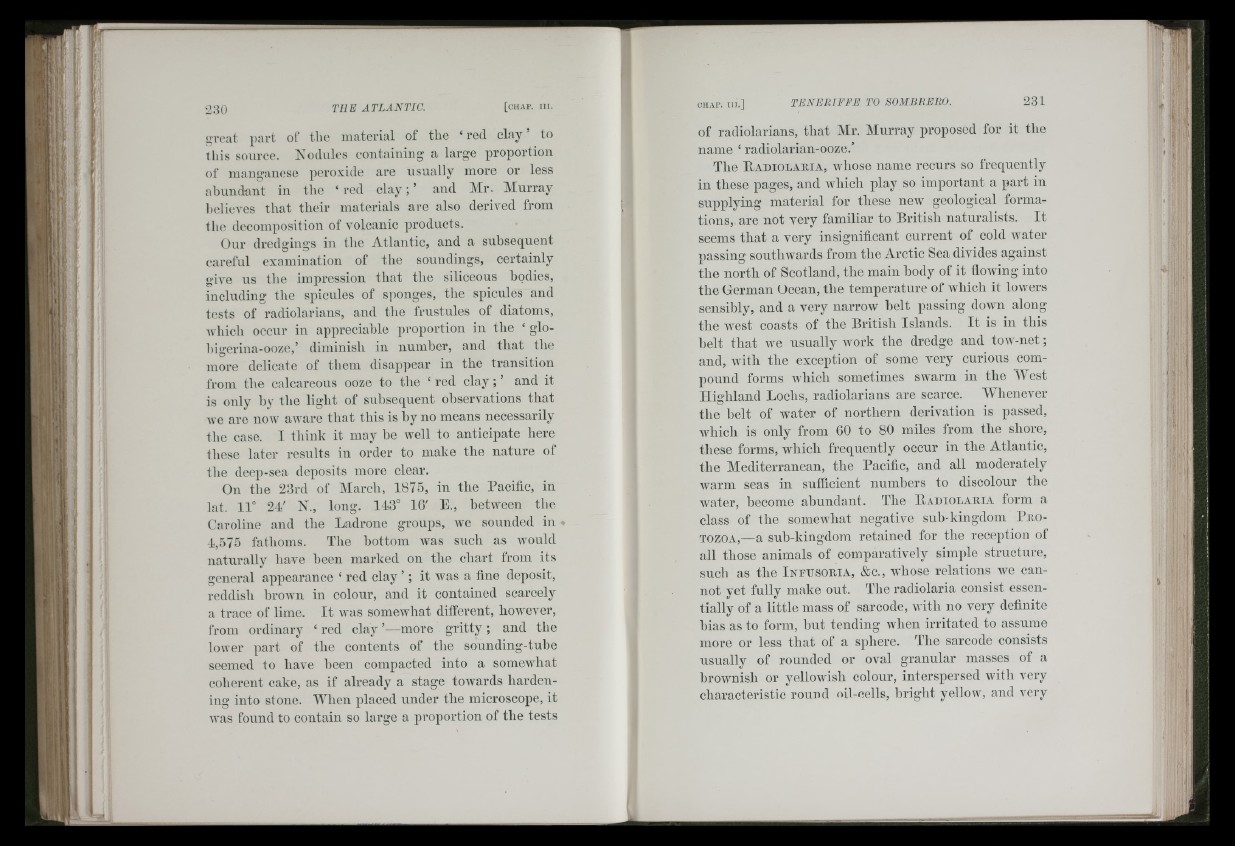
uIt:
0i-1 f *
,pM
m , i
p | j
I*- < «
I t3
«Si!
“tl'^i
‘! i | l
f- II l {
230 THE ATLANTIC.
great part of tlie material of tlie ‘ red clay to
this source. Nodules containing a large proportion
of manganese peroxide are usually more or less
ahundiiut in the ‘ red c la y ; ’ aud Mr. Murray
helieves that their materials are also derived from
the decomposition of volcanic products.
Our dredgings in the Atlantic, and a subsequent
careful examination of the soundings, certainly
give us the impression that the siliceous bodies,
including the spicules of sponges, the spicules and
tests of radiolariaus, aud the frustules of diatoms,
which occur iu appreciable proportion in the ‘ glo-
liigeriua-ooze,’ diminish in number, and that the
more delicate of them disappear in the transition
from tlie calcareous ooze to the ‘ red clay; and it
is only hy tlie liglit of subsequent observations that
Ave are u o a v aAvare that this is hy no means necessarily
the case. I think it may he well to anticipate here
these later results iu order to make the nature of
the deep-sea deposits more clear.
Ou the 23rd of March, 1875, in the Pacific, in
lat. 11° 24' N., long. 143° 16' E., betAA'een the
Caroline aud the Ladrone groups, Ave sounded in
4,575 fathoms. The hottom was such as would
naturally have been marked on the chart from its
general appearance ‘ red clay ’ ; it was a fine deposit,
reddish hroAvn in colour, and it contained scarcely
a trace of lime. It Avas somewhat diiferent, however,
from ordinary ‘ red clay ’—more gritty ; and the
loAver part of the contents of the sounding-tuhe
seemed to liaA'e heen compacted into a someAA'hat
coherent cake, as if already a stage toAvards hardening
iuto stone. When placed under the microscope, it
Avas found to contain so large a proportion of the tests
of radiolariaus, that Mr. Murray proposed for it the
name ‘ radiolariau-ooze.’
The B ad io la r ia , Avhose name recurs so frequently
iu these pages, and Avhich play so important a part in
supplying material for these ucav geological formations,
are not very familiar to British naturalists. It
seems that a very insignificant current of cold Avater
passing southwards from the Arctic Sea divides against
the north of Scotland, the main body of it floAving into
the German Ocean, the temperature of Avhich it lowers
sensibly, and a very narrow belt passing doAvn along
the Avest coasts of the British Islands. It is in this
belt that Ave usually Avork the dredge and toAV-net;
and, Avith the exception of some very curious compound
forms Avhich sometimes sAvarm in the "West
Highland Lochs, radiolariaus are scarce. Whenever
the belt of water of northern derivation is passed,
Avhich is only from 60 to 80 miles from the shore,
these forms, which frequently occur in the Atlantic,
the Mediterranean, the Pacific, and all moderately
warm seas in sufficient numbers to discolour the
AA'ater, become abundant. The B ad io la r ia form a
class of the someAvhat negative sub-kingdom P ro tozoa,—
a sub-kingdom retained for the reception oi
all those animals of comparatively simple structure,
such as the Infusoria, &c., whose relations we cannot
yet fully make out. The radiolaria consist essentially
of a little mass of sarcode, Avitli no very definite
bias as to form, but tending when irritated to assume
more or less that of a sphere. The sarcode consists
usually of rounded or oval granular masses of a
hroAvnish or yellowish colour, interspersed with very
characteristic round nil-eells, hriglit yelloAV, and very
A ■